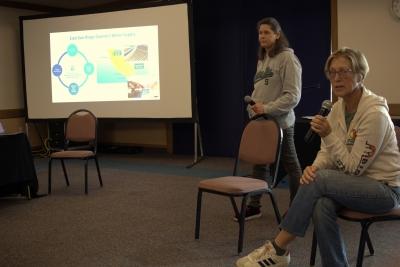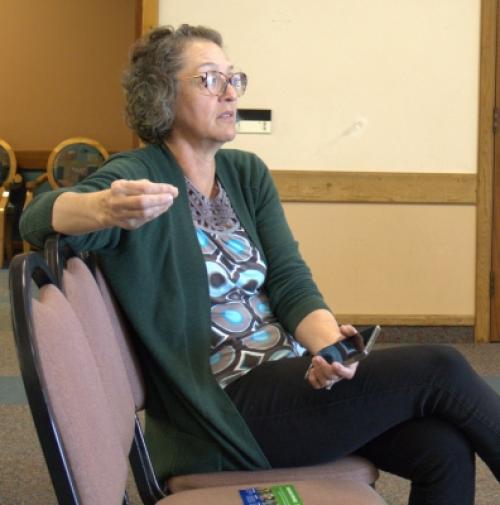Story and photos by Karen Pearlman

Photo, left: Padre Dam Municipal Water District board members Kim Hales (who represents Alpine) and Suzanne Till share information with ratepayers on Sunday afternoon, March 30, at The Alpine Club.
April 1, 2025 (Alpine) – Just a few days before San Diego County Water Authority will give presentation to the Padre Dam Municipal Water District Wednesday about wholesale water rates in 2026 and 2027, Alpine residents gathered to share some concerns about rate increases, as well as fire safety and water purification.
Two Padre Dam directors spoke Saturday at The Alpine Club. Alpine resident Anne Craig spearheaded the March 30 visit that brought Dr. Suzanne Till, who serves in Padre Dam’s Division 2 area, and Kim Hales, who oversees Division 4, including Alpine.
On Wednesday, Dan Denham, general manager of SDCWA will be talking about "Wholesale Water Rates: Strategies for Long-Term Stability at Padre Dam’s Wednesday meeting at its facility outside of Santee Lakes Recreation Preserve.

Photo, right: James Thomas asked questions about billing cycles for Padre Dam Municipal Water District
“I was the one that asked them to come out here and try to get as many people to come,” Craig said of the directors who spoke on Saturday. “It’s really funny. Everybody’s willing to complain about water and the cost but they’re not really willing to come and listen to what the governments are doing and that’s a bit frustrating too.”
Is there enough water to fight a wildfire?
While the cost of water is about to rise, wildfire danger is high on the list of concerns for Alpine, which has been hit several times in recent years with major blazes.
After the fiasco with the wildfires in January that hit Los Angeles County -- where water was not always available and a reservoir was empty – people are taking a closer look at what their needs would be in case a similar incident happens in East County.
Hales and Till told Alpine residents that they are as protected as can be.
Hales reminded residents that in the last electrical shutdown in Alpine, the town did not lose its water.
“They have backup generators in order to keep the water flowing out here because Padre Dam also understands if the fires are up here, firefighters need that water as well as the residents,” Hales said. “They’re equipped with backup generators, and I think back up to the backup as well, so they were forward thinking on that.”
Till said that Padre Dam takes extra steps when a Santa Ana weather pattern is expected in the region.
“If the fire danger is extreme, we pump up extra water up into this area,” Till said. “And then when we talk about the actual pumping infrastructure, there are many redundancies. Let’s say a pipe burst or something goes down, we have multiple ways to get water up here.”
The Cycles of Billing
James Thomas, who said he’s been a resident of Alpine since 1973, asked Till and Hales why the district’s billing cycles are not consistent. He said some cycles include an extra week, putting him into a higher tier, resulting in higher rates.
Till has been on the Padre Dam board since 2020 and said that when she was first running for a seat, she learned that the district’s billing cycle is a top question residents.

Padre Dam water rates increase with each of three different tiers. Each tier is incrementally higher and based on specific allotments. Residential water rates in Tier 1 are $9.06 per hundred cubic feet of water (where one HCF is 748 gallons); Tier 2 is $10.23 per HCF and Tier 3 is $11.76 per HCF.
Photo, left: Anne Craig organized the forum to make sure Alpine residents are able to have their voices heard.
“The way the rates are structured is you get X amount of water in Tier 1,” Thomas said. “For X amount of money you get into Tier 2 the price goes up. You get into Tier 3 and the price goes up even greater. The billing cycles are not uniform… 365 divided 12 is 30.41, but my billing cycles are 28 and then the next month it's 35 and then it's another number and another number. When you get into a billing cycle that’s 35 days as compared to 28, you’re gonna get in the next tier, you’re gonna pay more money. It’s simple math to me 365 divided by 12.”
Till said she will be meeting with Padre Dam General Manager Kyle Swanson this week to request that the concern be brought up on a future board agenda. She and Hales suggested that concerns like that be shared by constituents in an email to the district.
Getting Water Up and Water Rates Going Up
Anyone who’s lived in California or owned property in the state knows that water in Southern California comes with a hefty price, and one that’s about to go up again.
The costs of water in San Diego County, which by population is the state’s second largest county, are some of the highest around.
The San Diego County Water Authority notified residents that water rates will soar about 14% this year. The increase in rates is related to water treatment, water supply reliability, and water purchases largely tied to importing water. SDCWA imports the majority of the county’s water from outside the region and charges “pass-through costs.”
Last year, the Metropolitan Water District of Southern California adopted a two-year budget with rate increases of 8.5% in both 2025 and 2026, with the rates for treated water going up 11% this year and 10% next year.
“Everybody should be able to afford safe clean drinking water we should not have to go through this,” Till said. “And we’re talking 20% rate hikes of what’s projected 39.4 rate hikes over the next three years. That’s the reality of it… County Water Authority is around 39% rate percent rate hike for everybody in San Diego County over the next three years.”
Till said that while water rates are about to increase, she cautioned residents to “remember it does cost money to run those generators, it does cost money to run those pumps, it does cost money to put in (built in backups).”
“It’s not that we’re just providing your water, and for some people sewer, but we’re also assisting with protection for fire safety, too,” she said.
Till said Padre Dam relies 100 percent on imported water but to help allay the costs and take control of its own water supply, Padre Dam has been working on the East County Advanced Water Purification Program. (AWP) It has been partners with Helix Water District, the city of El Cajon and the County of San Diego on the project for a decade.
Planned to go online in late 2026, Padre Dam started the process with a demonstration facility that started operating at Santee Lakes in 2015.
The East County AWP will purify recycled water using advanced technologies like membrane filtration, reverse osmosis and advanced oxidation, ultimately producing near-distilled water. That water will then be blended with water in Lake Jennings, the reservoir overseen by Helix Water District, and treated again before being distributed as drinking water.
The project is one of the first surface water augmentation projects in California. When completed, it is expected to be able to provide 30 percent of Padre Dam's water supply locally.
Sourcing Energy from Bacteria
Another component leading to higher rates is the costs of electricity through San Diego Gas & Electric, Till said. The AWP plant will have its own energy source, so the district won’t have to rely on SDG&E.
The AWP’s final component involves the construction of a $50 million energy recovery system that will produce two megawatts of renewable energy generated from digester biogas and organic waste.
Hales, who is a biologist, said the energy source is part of its purification process, involving the bacteria that helps to break down the organics.
“Bacteria release gases and many industries will tend to use those gases, you know CO2 and that kind of thing, they tend to just burn it,” Hales said. “Instead of burning it off, those gases can be used for power. And so it’s being put back into the system as a power source. It’s a pretty slick system and because it’s locally controlled water, there’s a little more control over where money is being spent.”
Expected to be complete in 2028, the system will supply up to 40 percent of the electricity for the AWP’s water recycling facility as well as a solids handling facility, a product water pump station and a new Education Center.
